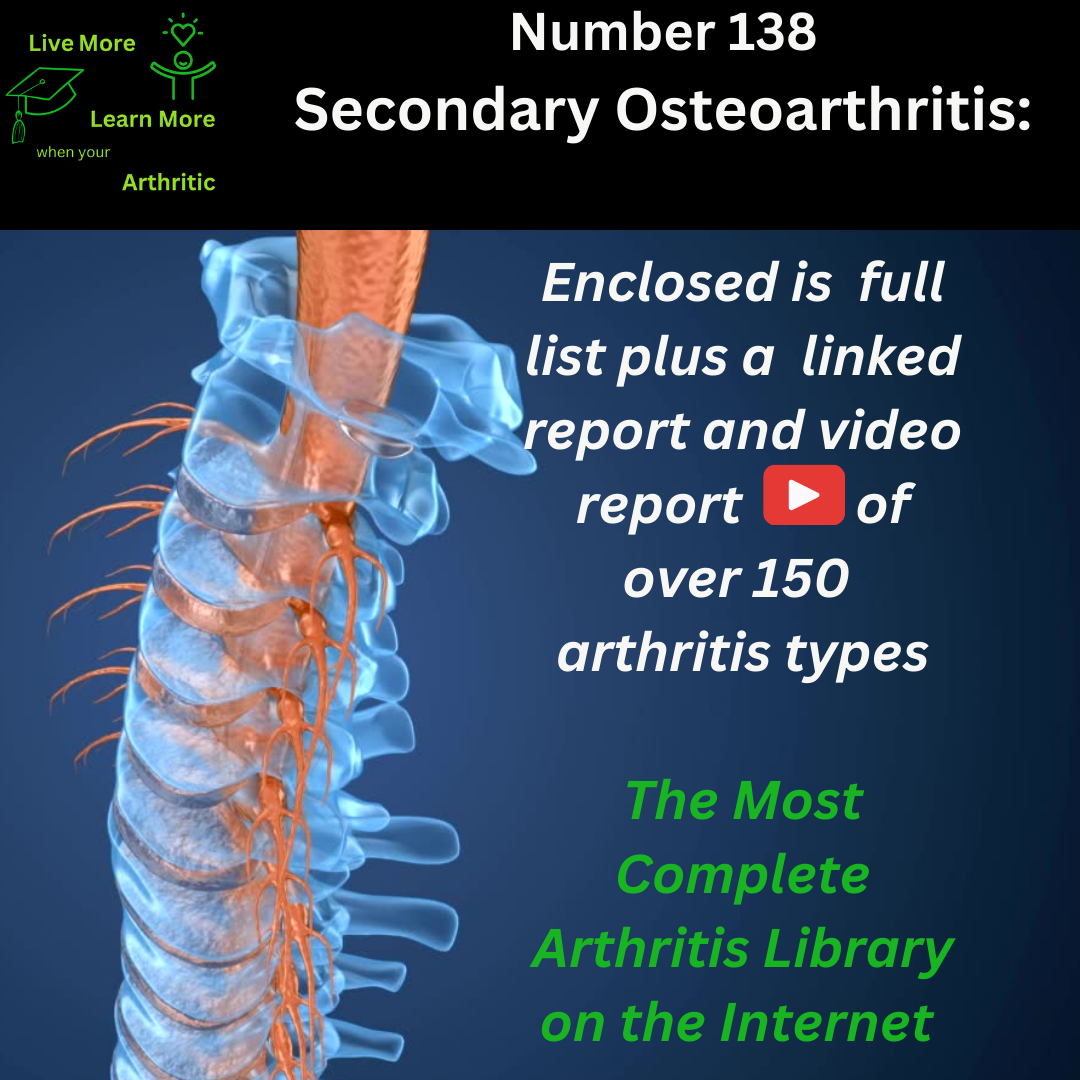
Secondary Osteoarthritis: Number 138 of around 150 types of Arthritis
Exploring Secondary Osteoarthritis: Navigating Life’s Twists and Turns
Secondary osteoarthritis is a condition that can affect various joints in the body, with certain areas being more commonly impacted than others. Typically, weight-bearing joints such as the knees, hips, and spine are most affected, followed by the hands and wrists. The distribution and severity of joint involvement can vary widely among individuals.
 Nature of Remission and Disease Description
Nature of Remission and Disease Description
Remission in secondary osteoarthritis is generally not achievable in the same way as with inflammatory conditions. This form of arthritis is often progressive and degenerative, driven by underlying causes such as joint injury, trauma, or pre-existing conditions like rheumatoid arthritis. Management focuses on symptom relief and slowing disease progression.
Causes, Triggers, and Age of Onset
Secondary osteoarthritis arises from underlying conditions or joint damage that accelerates wear and tear on cartilage. Causes include joint injuries, repetitive stress, obesity, congenital joint abnormalities, and inflammatory joint diseases like rheumatoid arthritis. The condition typically manifests later in life, with onset often occurring in individuals aged 45 and older.
Impact on Lifespan and Autoimmune Connection
Unlike autoimmune forms of arthritis, such as rheumatoid arthritis, secondary osteoarthritis is not an autoimmune condition. However, its impact on lifespan can be indirect, as chronic pain and decreased mobility can lead to reduced physical activity and associated health risks like cardiovascular disease or obesity-related complications.
Risk Factors and Complications
Risk factors for secondary osteoarthritis include a history of joint trauma or injury, congenital joint abnormalities, obesity, and certain occupations involving repetitive joint stress. Complications can include chronic pain, joint deformity, reduced range of motion, and functional limitations affecting daily activities.
Understanding Inflammation and Joint Tenderness
In secondary osteoarthritis, inflammation is less pronounced compared to inflammatory arthritis like rheumatoid arthritis. However, low-grade inflammation may contribute to disease progression and symptoms. Joint tenderness is common due to cartilage erosion and bone-on-bone contact, leading to increased friction and irritation within affected joints.
Impact on Range of Motion and Cartilage
The loss of cartilage in secondary osteoarthritis directly affects joint function and range of motion. As cartilage deteriorates, bones may rub against each other, causing pain and stiffness. Over time, joint spaces can narrow, leading to further limitations in movement and flexibility.
Lifestyle and Proactive Management
A proactive approach to managing secondary osteoarthritis involves lifestyle modifications aimed at reducing joint stress and maintaining overall health. Strategies include weight management, regular low-impact exercise, physical therapy, ergonomic adaptations, and joint protection techniques to optimize function and quality of life.
Complications and Common Age of Onset
Complications of secondary osteoarthritis can extend beyond joint-related issues to impact overall well-being and functional independence. This condition typically affects older adults, although joint trauma or underlying conditions can lead to earlier onset in some individuals. Secondary osteoarthritis affects both men and women, although specific risk factors may differ between genders.
 Differentiating from Primary Arthritis
Differentiating from Primary Arthritis
Secondary osteoarthritis differs from primary osteoarthritis in that it develops as a consequence of underlying joint damage or predisposing factors, rather than solely due to age-related wear and tear. Primary osteoarthritis, on the other hand, typically occurs with aging and without a specific precipitating cause, affecting joints commonly subjected to mechanical stress over time.
In summary, secondary osteoarthritis presents unique challenges due to its underlying causes and associated complications. While remission may not be attainable, proactive management strategies can help optimize quality of life and mitigate the impact of this degenerative joint condition. Understanding the differences between secondary and primary arthritis is crucial for tailoring effective treatment approaches and enhancing overall well-being for individuals living with osteoarthritis.
